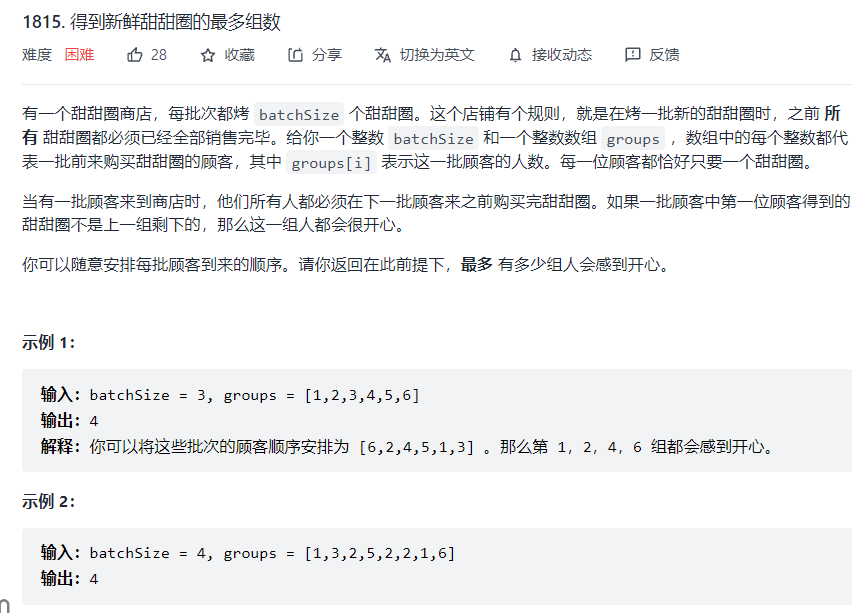模拟退火算法
模拟退火算法是求解最优化问题的一种手段。
一种随机算法,相当于爬山,我们总是往高处爬,即使下一步的位置低于现在的位置,考虑到局部最优解的存在,我们也以一定概率接受它。
step1:先设定好初始温度t0=最高温度tMax, 随机选定一个初始状态i,计算f(i);
step2:若在当前温度下达到内层循环的退出条件,则转step3执行;否则,从邻域N(i)中随机选择一个状态j, 并计算出exp((f(i) - f(j))/temperature),
若exp((f(i) - f(j))/temperature)>random(0, 1), 则重复执行step2;
step3: 若温度t满足退出条件,则转step2执行;
/*
* J(y):在状态y时的评价函数值
* Y(i):表示当前状态
* Y(i+1):表示新的状态
* r: 用于控制降温的快慢
* T: 系统的温度,系统初始应该要处于一个高温的状态
* T_min :温度的下限,若温度T达到T_min,则停止搜索
*/
while( T > T_min )
{
dE = J( Y(i+1) ) - J( Y(i) ) ;
if ( dE >=0 ) //表达移动后得到更优解,则总是接受移动
Y(i+1) = Y(i) ; //接受从Y(i)到Y(i+1)的移动
else
{
// 函数exp( dE/T )的取值范围是(0,1) ,dE/T越大,则exp( dE/T )也
if ( exp( dE/T ) > random( 0 , 1 ) )
Y(i+1) = Y(i) ; //接受从Y(i)到Y(i+1)的移动
}
T = r * T ; //降温退火 ,0<r<1 。r越大,降温越慢;r越小,降温越快
/*
* 若r过大,则搜索到全局最优解的可能会较高,但搜索的过程也就较长。若r过小,则搜索的过程会很快,但最终可能会达到一个局部最优值
*/
i ++ ;
}
看一道例题:

class Solution {
int m;
Random random;
int max=0;
public int maxHappyGroups(int batchSize, int[] groups) {
if(batchSize==1){
return groups.length;
}
m=batchSize;
random=new Random();
for(int i=0;i<50;i++){
backfire(groups);
}
return max;
}
//计算当前排列的高兴的组数
public int value(int[] w){
int n = w.length;
int res = 0;
for (int i = 0, s = 0; i < n; i++) {
if (s == 0) res++;
if (w[i]>s){
s= (w[i]-s)%m ==0? 0:m-(w[i]-s)%m;
}else{
s=s-w[i];
}
}
max=Math.max(res,max);
return res;
}
public void backfire(int[] groups){
double r=0.97;
int n=groups.length;
for(double t=1e6;t>1e-6;t=t*r){
int value1=value(groups);
//随机交换位置
int a = random.nextInt(n);
int b = random.nextInt(n);
if (a == b) b = (b + 1) % n;
swap(groups,a,b);
int value2=value(groups);
int d=value2-value1;
if(d>0){
continue;
}
if(Math.exp(d/t)>Math.random()) continue;
swap(groups,a,b);
}
}
//交换数组中的两个元素的位置
public void swap(int[] groups,int i,int j){
int temp=groups[i];
groups[i]=groups[j];
groups[j]=temp;
}
}
我有一壶酒
足以慰风尘
尽倾江海里
赠饮天下人



 浙公网安备 33010602011771号
浙公网安备 33010602011771号